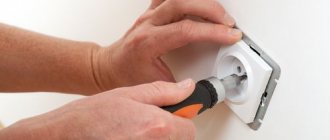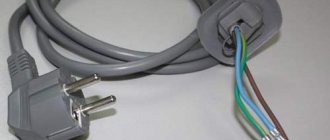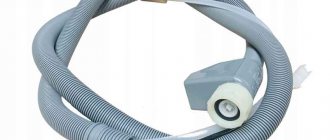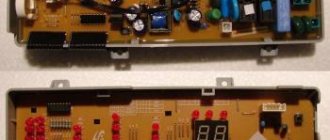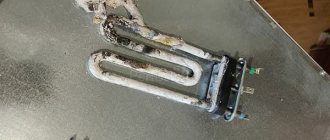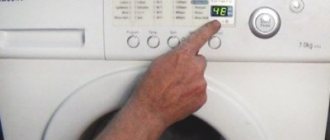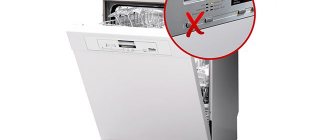machines » The washing machine does not work, does not turn on.
The operation of the automatic washing machine completely depends on the control unit - all recorded programs are stored in its memory, it receives information from sensors and switches, generates commands, sends them to the valves, pump and motor. If a failure occurs in any of the chains, the machine begins to work differently than you expected and does not carry out the program. But there are cases when a special algorithm is triggered - it is responsible for safety, preventing breakdowns and emergency situations. Then the washing machine does not turn on at all or does not start the program.
What are the faults that lead to such situations? Our experts will tell you about them.
Service is a company that provides repair services for washing machines and other household appliances at home with a technician visiting Moscow and the region.
We accept requests for service by phone +7 or through the feedback form on the website.
Masters work daily from 8:00 to 23:00. Spare parts and components installed during the repair process are provided with a warranty from the service center. The washing machine does not work - this wording does not actually reflect the entire situation and does not provide information about what breakdowns and problems you are encountering. In a complex device that is connected to the electrical network, water supply and sewerage, different chains are involved, and each of them may not be used. in this case, either the programs will not be executed, or the machine will not turn on at all.
Let's look at the most common situations and explain the reasons for their occurrence.
Why does the washing machine show no signs of life?
A complete lack of response to your actions is not necessarily a malfunction. There may be several reasons.
- There is no power in the network - the circuit breaker is knocked out, there is no electricity in the house.
- The socket or the wire leading to it is faulty.
- The internal wiring in the washing machine is damaged.
- The power filter is triggered during voltage surges.
In all these cases, the washing machine either does not turn on at all or turns off immediately because its accident protection is triggered.
Power outage
There is no electricity in the apartment, in the entrance to the house. Check the machine - it may have been knocked out at the start of the washing program, when the heating element of the water heater turned on.
Broken network cable
If the wire breaks, not a single device connected to it will work - unplug the washing machine from the socket, try turning on a lamp or other device. If the machine on the site is turned on, then there is likely a fault in the wire or socket. Do not disassemble the socket! Is it dangerous!
Power button failure
The power button of the washing machine is responsible for connecting it to the power supply. If this unit malfunctions, the machine will not show signs of life. But this is not just a switch - this unit has a complex device with protection systems, so it cannot be disassembled. Diagnostics and repair of the button on the washing machine is carried out only by a service center technician.
FPS interference filter malfunction
Samsung, Indesit, Bosch, Candy, LG, Ardo, Zanussi, Electrolux, Beko washing machines have a voltage filter installed - in case of power surges, this unit disconnects the machine from the power supply so that it does not get damaged. A malfunction of the FPS leads to a complete break in the machine’s power supply, during which it may not turn on at all.
Control module failure
Problems in the electronics module are the most difficult because this module issues all the commands. If it malfunctions, everything is possible - from incorrect execution of programs and the machine going into a cycle to a complete failure to start the program. The dashboard may display incorrect information. The module is completely replaced and cannot be restored.
What to do if the car engine does not work
A visual inspection of the unit will help identify the breakdown. How to get to the electric motor:
- Disconnect the SM from the network.
- Move the equipment away from the wall to make dismantling easier.
- Unscrew the mounting screws and remove the back panel.
All that's left is to get the motor. Remove the belt from its pulley, disconnect the contacts and unscrew the bolts.
To identify the problem, you need to connect the rotor and stator windings. Connect a 220 Volt AC source to the free connectors. Is the node working? So everything is fine. Does not move? That means it's faulty.
Pay attention to the brushes and slats. Determine the degree of their wear.
Replacing brushes
If upon inspection it turns out that the length of the brushes is less than 5 mm, replace them. Prepare identical parts in advance, because they are different for each washing machine model.
When you start the engine, the brushes spark, but when checking, you noticed that they were almost not worn out. This is possible when installing new elements or connecting equipment for the first time. As soon as the brushes rub in, the sparking will stop.
To replace, disconnect the contacts of the parts and remove them from the assembly. Install new items.
Winding diagnostics
Why diagnostics? Because if the windings malfunction, they need to be rewinded. This is an expensive and unprofitable repair. It's easier to replace the entire engine. But you can check the windings for open circuits and short circuits yourself:
- Set the multimeter to ohmmeter mode.
- Apply the probes to adjacent lamellas one by one.
- Normally, the difference in indicators should not be higher than 0.5 Ohm.
- If the resistance does not match the specified value, then there is a short circuit. At the same time, you could smell something burning.
- The following diagnostics are also carried out: attach one tester probe to the stator housing, and alternately check the contacts with the other.
- If everything is in order, then the readings on the screen will be hundreds of ohms.
Slat repair
Inspect the slats. Minor flaking can be eliminated by turning the manifold on a lathe. After work, the elements are cleaned of dust and installed in place.
Upon inspection, it may turn out that the contacts have broken. It can be difficult to restore them yourself, so it is better to contact a specialist.
The machine turns on, but the washing program does not start - what should I do?
Most likely, you are dealing with a complex situation - from a broken control module to a failure in any circuit. The washing machine does not start if any of the sensors reports a problem - this could be insufficient water level in the tank, an open loading hatch, a signal of overheating of the motor winding... There are many such reasons.
In this case, experts recommend checking several options sequentially:
- turn off the program, run another program, try restarting with a complete shutdown of the machine;
- make sure that the car hatch is closed;
- check whether the water supply tap is open if the program stops running after the valve clicks;
- make sure the drum is not overloaded.
If a program starts and then immediately stops, something is going wrong. If you have checked all the signs we have listed and nothing helps, turn off the machine and call a technician from the service center.
Hatch door lock malfunction - UBL
The loading hatch lock of the washing machine is responsible for the safety of its use, so it can block the start of the program - if the sensor believes that the hatch is not closed, the machine control module will not give the command to start washing. Usually the machine reports this situation as an error - a code is displayed on the control panel.
If you turned off the car, turned it back on and re-closed the sunroof, but this did not help. then most likely the issue is a malfunction of the UBL. An indirect sign that there are problems in the lock is that after turning off the car you have to wait longer and longer for the hatch to unlock and open. If you notice such a phenomenon, then call a technician without waiting for the malfunction to become critical.
Failure of the hatch locking device
If the power indicator on the washing machine is on, the control module allows you to select a washing program, but after activating it, an error message like “Error” appears on the display, then you need to check the functionality of the hatch locking device - UBL. It is a latch whose operating principle is based on the movement of a bimetallic plate. Long-term use and constant temperature changes can deform the plate and damage the device.
The first sign of a UBL malfunction is the absence of a click when closing the loading hatch door. For a deeper check, you need to partially disassemble the washing machine and disconnect the device. This is done as follows:
- The fixing clamp is removed from the hatch cuff.
- The cuff is bent from the UBL side.
- The two fixing bolts are unscrewed and the lock mechanism is removed from the inside.
- The wires are disconnected.
- The value is measured on the lock contacts with a multimeter.
If the UBL is faulty, then we replace it with a new one. The cost of such a part is quite low, and there is no particular need for repairs. If the blocker is working, then the reason for the failure of the washing machine may lie in the electronic control unit or command device.
UBL
There are cases of UBL failure during the washing process, or when the hatch door is closed. To unlock the door, you need to remove the top cover of the washing machine and press the door latch protruding from the hole on the back of the lock.
In some cases, the terminals of the connector connected to the blocker burn out. They need to be replaced, since a poor connection between the contacts quickly leads to repeated burnout of the device.
The washing machine turns on and starts every other time - should I call a technician?
If you notice that in order to start your car you increasingly have to reboot it, re-configure the program, or close the hatch several times, call a technician. This is a sign of a gradually growing problem, which will soon manifest itself in all its glory, unexpectedly, when you urgently need your washing machine in good condition.
In a complex device, a fault may appear as a temporary glitch that appears to be random. If you notice that such temporary failures follow one after another, repeat, or arise as yet another surprise, then it is better to contact a service center - after diagnosing the washing machine, it will become clear what the problem is. where the fault is located.
Do not forget that the error codes specified by the manufacturer are not instructions for action. They indicate that the control unit has received some information. The specialist will find out how accurate it was based on the diagnostic results.
Line filter failures
Each modern model of washing machine has a device such as an interference filter or surge protector. It is designed to smooth out electromagnetic pulses resulting from the operation of the electric motor and heating element. If the mains filter breaks, the washing machine does not turn on or off. In some cases, the network indicator may be on, but the programmer does not respond to commands. The second situation can also arise when the programmer (control module) or command device fails. But since these devices are quite expensive and difficult to repair, it is necessary to first exclude all other faults.
Diagnosis of a network filter malfunction is carried out as follows:
- The washing machine is disconnected from the power supply.
- The screws around the perimeter of the rear panel are unscrewed, after which the case cover and rear panel are removed.
- A multimeter is used to test the contacts of the interference filter in resistance measurement mode.
It should be noted that the interference filter cannot be repaired, and in the event of failure, only replacement is necessary. Purchasing new parts is not particularly difficult, since their characteristics are similar for entire model series.
Network filter
IMPORTANT!
In fact, the washing machine can operate without an interference filter. To do this, the contacts from the power cord are directly connected to the outgoing wires coming from the filter (as shown in the photo). But this method of “repair” can lead to dire consequences. The interference filter also protects the internal elements of the washing machine from external influences (voltage drops): control board, wiring, heating element, electric motor.
Replacing the filter is quite simple:
- The place where the wires are connected is photographed.
- The incoming wires from the power cord and the outgoing wires to the command device are removed.
- The bolts securing the element to the body of the washing machine are unscrewed.
- A new filter is installed, all terminals are connected to its connectors in the same order.
How to repair a washing machine cheaply?
The cost of repairing household appliances depends on the price of spare parts. This is the main criterion - if you intend to save money and use used, substandard, counterfeit parts, then get ready to pay much more soon - you will need repeated repairs.
Installation of high-quality spare parts is a guarantee that the service center gives because it purchases components from a reliable supplier and manufacturer. You do not have this opportunity, so you are not able to repair the washing machine yourself. Contact the service center.
Types of washing machine engines
Automatic washing machines that are in consumer homes today can have one of three types of electric motors:
- Asynchronous, used in older models. The simple design, consisting of a starter and a rotor, has a low cost and operates quietly. But due to its large dimensions and low efficiency in modern cars, this motor is not used;
- Collector, this is the type used in most modern models of machines. Belt transmission of rotation from the engine to the drum. Compared to the previous type, it is smaller in size, has high operating speed and is independent of the frequency of the electrical network. Main structural elements: starter, rotor, tachogenerator, electric brushes. Very often, you can repair such an engine yourself;
- Brushless or direct drive motor. A striking example of modern washing machines with this type of engine is the LG model range. Connected to the drum directly, without a belt. Such a motor is three-phase, the commutator is multi-pole, and the rotor is permanent magnet. It has a similar structure to asynchronous, but smaller in size, with high efficiency, hence the high cost of such devices.
Breaks in rotor and stator windings
In the event of a break in the stator and rotor windings, the user will observe the following malfunctions in the operation of the machine:
The problem can be easily determined by using a device called an ohmmeter. We connect it to any of the lamellas and rotate the rotor ourselves. If in any position of the shaft the resistance value of the lamellas is the same and equals from 0.1 to 0.4 Ohms, then everything is in order. Usually, if there is a break, the value can increase to 10 Ohms, but the reason may also be that one of the lamella hooks is disconnected. It will not be possible to restore contact by soldering. Severe overheating will destroy it, and the voltage circuit will break again.
A short circuit can also be caused by breakdowns in insulation. Unfortunately, repairs will not help here; it is necessary to change the motor or completely rewind the windings. To do this correctly, you need to follow certain technologies that cannot be done at home. A broken winding also leads to other very serious problems in the washing machine, which can render it unusable.
If the indicators on the Indesit washing machine are blinking
It happens that during the washing process, all the indicators on the front panel of the washing machine suddenly begin to flash, a buzzer sounds warning of a breakdown, and the operation of the unit stops. The lights can light up alternately, in different combinations, or all at the same time. In any case, such blinking indicates abnormal operation of the washing machine.
There are many reasons for the appearance of cheerful illumination. Only sometimes are they associated with serious breakdowns; often they are the result of simple carelessness.
Causes
The instructions supplied with the machine by the manufacturer describe in detail common problems and how to fix them. Here are some normal situations in which the washing machine blinks all the buttons, and solutions.
- Water is not pouring. Check if there is water in the water supply; is the tap on the pipe leading to the machine open? Is the inlet hose kinked?
- Program crash. The unit is disconnected from the network for a few minutes and started again.
- Water does not drain. Check the drain hose and the connection point with the sewer hole; If necessary, clear the blockage.
- The power cable, plug or socket is damaged. Replace damaged elements.
- Incorrect download. They control the amount of laundry in the machine, remove excess, and distribute things evenly throughout the drum.
- Incorrect installation of the unit. The drain hose is located above the level of the machine drum.
If all of the above problems are corrected, and the blinking does not stop, it is better to seek help from professionals.
Error code
A modern automatic machine is equipped with special devices that allow you to control washing, rinsing and spinning, and in case of a problem, they report this using LED lights. To understand the system messages, you need to guess the error code based on the set of indicators involved. A list of all possible codes can be found in the instructions for the model.
The new generation of Indesit washing machines has a display on which an error code is displayed. All that remains is to read what exactly the malfunction has occurred and whether you can deal with it yourself.
The washing machine does not turn on: common causes of breakdowns
Before unscrewing the device or pressing the operating panel buttons, you should:
- Double-check, what if you simply forgot to plug it in?
- Double-check whether there is voltage in the network (by plugging in any other electrical appliance).
- Check if the cord and plug are damaged. There should be no creases, tears, or traces of burning.
Is everything okay with the cable, socket, plug? This means that the SMA does not work due to malfunctions in the “internals” of the unit itself.
Depending on the cause of the failure, the device may require:
- Simple repair. Problems can be easily eliminated without special knowledge and skills or special tools.
- Complex, expensive repairs, including comprehensive diagnostics of faults, replacement of individual parts and assemblies.
The most common reasons why the washing machine refuses to turn on:
- The hatch door for loading laundry is not closed. If the lock does not work (the latch does not click), the device will not give the command to start. The cause of the breakdown is obvious - a malfunction of the hatch locking device (UBL). There is only one way out - replace the faulty element with a new UBL.
- The “ON” button is broken. The malfunction can be determined by ringing the wires going to it and the entry and exit points (in working position). No ringing? The only correct solution is to buy and install a new button.
- The electronic module is broken. You can repair it if you have experience working with electrical engineering. Isn't there one? Contact the service center immediately. The specialist will determine the need for repairs and replace faulty elements.
- The interference filter has failed. This part eliminates interference that appears during the start of the cycle, disrupting the operation of other equipment installed nearby. You can determine whether the filter is broken using a tester by ringing the contacts. The part does not work - you will have to replace the filter and the machine will work again.
- Internal wiring faults. The indicators blink, but the device itself does not function. Perhaps the lights were turned off for a short time when you were not at home. Visually inspect the wires and mounting sockets. Did any fall out? Paste in their original places. Replace burnt ones with new ones.
Worn motor brushes
If the brushes on the motor are not changed in time, this may cause the washing machine motor to stop working. You can determine the problem yourself by inspecting the collector. If during operation it sparks strongly (not necessarily around the entire perimeter), then the problem is obvious. If parts are replaced, at first they may also spark, which is normal, it’s just that the new brushes have not yet gotten used to the commutator. Loss of power is also a wake-up call. Warped brushes may not produce enough current and the motor will not be able to turn the drum.
It is recommended to install original brushes, since analogues can cause many problems during installation for several reasons. Analog brushes have slightly different dimensions and shapes, so they will have to be pre-treated. Finding a brush of the required length can take a long time, since different brands of washing machines differ greatly in this component. A self-made brush requires additional verification of its smooth movement without lateral play, which can cause jamming.
How to choose motor brushes
The durability of the brush is affected by its hardness. The presence of a copper tip is mandatory if it was also installed on the old brush. Graphite brushes should not be used; they are designed for low voltage use. After installing the brush, you need to let the motor run at low speeds.
Source
We do it ourselves!
Before you start repairing your washing machine yourself, you need to make sure that the plug is connected to the outlet. Perhaps the reason is that the household appliances are simply de-energized. After all, we often forget to check the simplest option and immediately sound the alarm. Then we will check the presence of electricity in the network. To do this, you can connect any electrical appliance and check its functionality. If there is electricity, the machine is connected to the network, but it still does not turn on, then it’s time to start repairing.
Is the outlet working?
To check the health of various conductors that may break, it is best to use a tester. This device is also called a multimeter. Using it, we will look for faults by “ringing” various wires, etc. Brief video instructions on how to use a multimeter here:
In order to check the socket, you can also use an indicator screwdriver or some other electrical device. For clarity, it is better to use a lamp. If the lamp connected to this socket lights up, then the socket is working. If it doesn’t light up, then we have found our breakdown. And all that remains is to eliminate it.
To do this, we will turn off the power to the apartment. This is done in the shield. Then, using a screwdriver, remove the cover and repair or replace the socket. For clarity, we attach a video:
Is the network cable working?
If used carelessly, the washing machine's power cord may become damaged. Usually it frays or breaks
In order to check this type of malfunction, let's check the wires using a multimeter. If you find a break, it is better to replace the entire wire. As a last resort, you can find the break point and fix it with a twist or soldering iron. But we do not recommend this option.
Broken button that turns on the machine
If your machine model is not new, then the breakdown may be related to the button that turns on the machine. There are two wires connected to the button. Using a tester, you need to make sure that these wires, as well as the button itself, are working properly. Let's check the button both in the off and on positions. If during the process of “ringing” with a multimeter you find a faulty button, then we order a new one and replace it.
Module and command apparatus
If all previous checks have shown that everything is in order, then we move on to the next possible reason - module failure. As in our other articles, we do not recommend repairing or changing the electronics module of a washing machine on their own for those people who do not have sufficient skills in solving similar problems.
But before you call a professional, you may want to check for other possible problems.
Interference filter malfunction
There is a possibility that the interference filter has failed. This part of the washing machine is needed only to ensure that various household appliances, such as a TV, radio and computer, do not interfere with the operation of the machine. It may break during long-term use of the washing machine or due to a short circuit. Three wires are connected to it at the input, and two at the output. We will also ring it using a tester and make sure that it is working properly. If it is faulty, then we buy a new one and replace it.
Lock failure
If the lock is faulty, then you may observe the following problem: when connected to the network, the indicator lights up. But even with the hatch closed, the washing does not start. In order to check if there is voltage at the lock when the washing machine is turned on. If there is voltage and it does not perform its functions, then it needs to be replaced.
Instructions for replacing the lock yourself in video format are here:
Violation of integrity and breakage of electrical circuit wires
During operation of the washing machine, some wires may come into contact with individual parts. This situation may cause friction and broken wires. Also, due to vibrations, they can become disconnected from the mounting sockets. In order to detect this malfunction, you must carefully examine all the wires. Such an inspection will make it possible to detect this malfunction. You can also “ring” suspicious places with a tester.
We hope this material will help you solve the problem. Happy renovation!
Malfunctions of the collector lamellas
During prolonged operation, the lamellas begin to overheat, as a result of which they peel off and may lose contact with the rotor winding module. The lamellas are fixed to the collector using a special adhesive. And with the rotor winding, electrical contact is created due to the presence of hooks. One of the reasons for overheating is a broken cord at the junction of the rotor section with the lamella.
Also, the problem may arise due to a short circuit in a section of the winding, this leads to an increased supply of electricity that the lamellas cannot withstand. This is facilitated by jamming of bearings, which occurs due to unfixed drum flaps during washing. That is, a defect with lamellas indicates the presence of another breakdown in the electric motor or in the washing machine. Incorrect operation of the machine by the user also leads to deformation of the lamellas.
It is easy to identify a defect; just perform a visual inspection. When the motor rotor is manually rotated, the lamellas will make a loud cracking sound. If the peeling of the surface of the lamellas is insignificant (0.5 mm or less), then the problem can be solved by turning the commutator on a machine. After performing this procedure, it is necessary to clean the surface from copper shavings, dust and burrs.
Failure of the control module or command device
The selection and launch of the functions of the washing machine is carried out by an electronic module or a command device (programmer) in models with analog control. Diagnosis of malfunctions of these devices is carried out only after all other options have been excluded, and the washing machine turns off anyway. These are the most expensive components, which are also difficult to repair at home.
Control module
As for the control board, the maximum that can be done without an electronics engineer’s education and a special soldering station for microcircuits is to remove the device and carefully inspect it for physical damage and contamination of contacts, as well as swollen capacitors.
If, with sufficient experience and dexterity, you can try to re-solder the capacitors yourself, then a burnt-out microcircuit can only be replaced at a service center. However, in most cases, such repairs will be comparable in cost to ordering a new control board.
ADVICE!
The electronic module and programmer are quite expensive parts. Therefore, if you are not sure about their malfunction, it is recommended to send it to a service center for diagnostics.
Command apparatus
The command device is used on washing machine models with control knobs. To diagnose and repair it (or rather prevent it), perform the following steps:
- Remove the front control panel and the cover of the washing machine to gain access to the device.
- Disconnect the command device, having previously photographed the location of the connection wires.
- Completely disassemble the device. By pressing the plastic latches on the sides of the case, you can remove the cover and disconnect the board.
- Inspect the board thoroughly and if you find burnt tracks, solder them.
- Clean all contacts and measure their resistance with a multimeter.
- Disconnect the center gear from the core.
- Thoroughly clean the nest from dust, treat the gears with alcohol and reassemble in reverse order.
IMPORTANT! For most modern models of washing machines, if analog control is combined with a large number of functions, the programmer is too complex and cannot be repaired.
